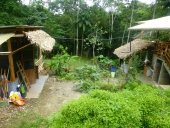Agree, totally. But firstly I would search for models. In expensive situations like my country, to rise your standards of living is much harder than lower it. So, I would suggest getting in touch with people first, the more you can, from any culture, but especially from your own.
So now, any ethics and sustainability plans are left behind, just like holistic management, when you choose a secondary goal that will take you to action, to meet in the future, your final goal.
MODEL EXAMPLE: I got a friend that started a little permaculture site. He built a skate board ramp and a little bar. From the money that he earns with this venture he can now, start doing some permaculture.
LIMITATIONS: He had to buy a place where it is more suited to a bar, rather than a place to grow food or a place where you might have some peace of mind. This could be a big cost to pay for the majority of permaculture lifestyle seekers, even for him, but that is the price to pay sometimes.
POTENTIALS: Your future can hold what your money can buy (very true in Brazil). Lots of brazilians can not afford good food, so if you can afford to buy your own place, this can be a luxury around here. My friend’s model is simple and smart; he designed his plan strongly linked with a positive cash flow (the bar).
EXAMPLE FROM THE UK
“It may be surprising to hear that 50% of the initial private investment went on purchasing the land, and the other 50% on setting up the yurt camp. It’s worth considering the full cost of setting up your livelihood before purchasing land, as without that capital investment you could find yourself in financial difficulties very quickly. Doug and I are also self-employed and still currently earn money outside High Nature Centre as the business is predominantly seasonal at present.”




